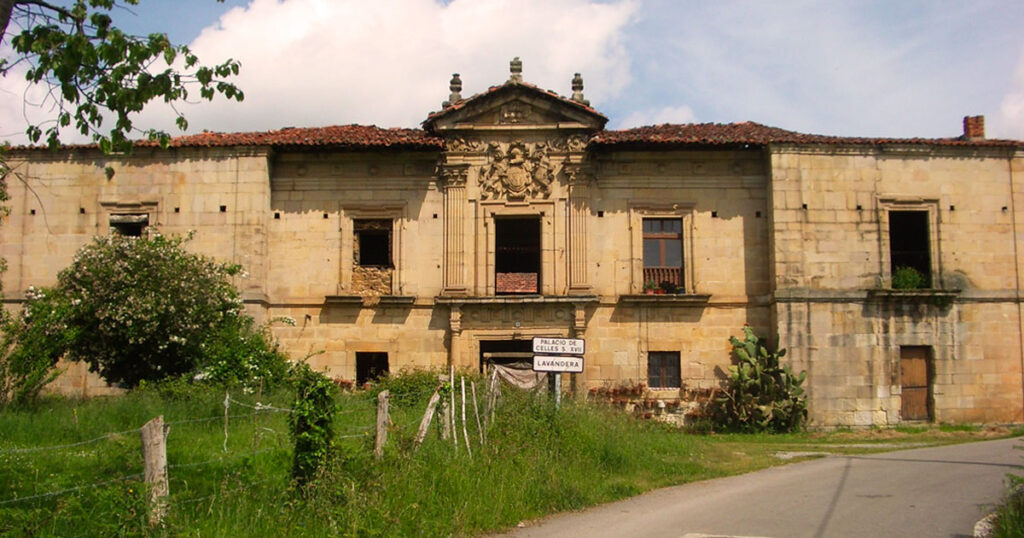
I first saw the Palacio de la Torre de Celles on a summer’s day, and quite by chance. The building was not easily visible from any of the lanes crisscrossing the hilly countryside near the town of Pola de Siero, where the manor is situated, and I saw it only because my running partner and I stopped to stare at a bit of stone tower emerging from a great tangle of briar. “What’s that?” I asked. My friend didn’t know. So we investigated.
No sign told us to keep out, and no fence stopped us. On an empty country lane with no houses in sight, no cars or walkers, we stepped across the invisible boundary onto the grounds of whatever ruin was mostly hidden in the wild growth, and ducking around and then through the tangles of briar, we were soon well hidden ourselves. We pushed on, following a track that was overgrown with stinging nettle. Then we saw a wall, evidently the back of the grand building, and it was crumbling. Windows were minus their casements and the doorway we found was minus its door. When we stepped over the threshold into the gloomy interior, we could make out a lot of rubble from fallen stones and timbers, but not much else in the darkness. This was not the first abandoned building I’d poked my nose into. Had someone come along and asked gruffly what I thought I was doing, I’d have felt like a child caught with her hand in the cookie jar. But aren’t cookies to be eaten? Aren’t abandoned buildings to be explored?
Besides the rubble, we found some old artifacts, such as a chain, no dog attached, a cooking pot, some moldy blankets, and several heaps of plastic trash, colors faded. I’d have liked to return with a flashlight to investigate the inner reaches of the building, which though in a sorry state did not seem in danger of falling. Instead, at home I looked up the building and found it was protected as a monument, meaning it could not be torn down. What’s more, restoration would be according to strict official rules. In 2013, the owner, a descendent of the original owners, had petitioned to have the building declared a ruin—to escape the responsibility of restoration and upkeep—and the Internet revealed bits of the history of the legal back-and-forth. Negotiations were ongoing. And then I forgot about the place.
But another outing this winter took me down the same lane, where to my surprise I saw the denuded walls of the building, and all around the property a temporary chain link fence such as you find at construction sites to keep out intruders. A sign warned that no one except workers for the company was allowed in. Evidently the suits and countersuits had been satisfactorily resolved. The society for the preservation of the patrimony had presumably prevailed after many years, and the manor has been bought. Thank goodness. Every reference I saw to the building marveled at the majesty of its façade and described the building as the best example of baroque architecture in Asturias, or even Spain.
So, the new owners have begun the work of saving it. The enticing glimpses of stone wall and tile roof we caught are impossible now because all the vegetation has been cleared away. The manor stands free. It looks unprotected, abashed. The expansive, much-lauded south façade is visible, no peeking or prying necessary. Yet one quiet Friday afternoon, when construction workers do not work, I slipped behind the fence, gawked at the enormous pile of oak and chestnut beams in the yard, admired the careful stacking of the ancient roof tiles, marveled at the precautionary bracing in all the windows and doorways to keep everything from tumbling down. Then, through the main portal, I entered the manor. Nothing had been restored or rebuilt, but it had been cleared, and the 12 carved stone columns in the courtyard that had supported the balconies of the second floor were beautifully in evidence. And there I saw the great arched entrance to the wide stone stairs ascending to the upper floor. All the floors themselves were missing—nothing on the second floor and only dirt on the ground floor. It was quiet, sunny, and peaceful, but I did not linger. I patted a pillar as I might the leg of some enormous tired mammoth, brought back from the dead, and I left.
Who has the money for this restoration and for what purpose? A Madrid company is the new owner, I read. An events center is the future of the manor. An events center. For weddings or parties. Won’t that be pretty—the grand manor, the best example of baroque architecture in Asturias or possibly all of Spain, festooned and glorious. A palace for the rich, once again.

